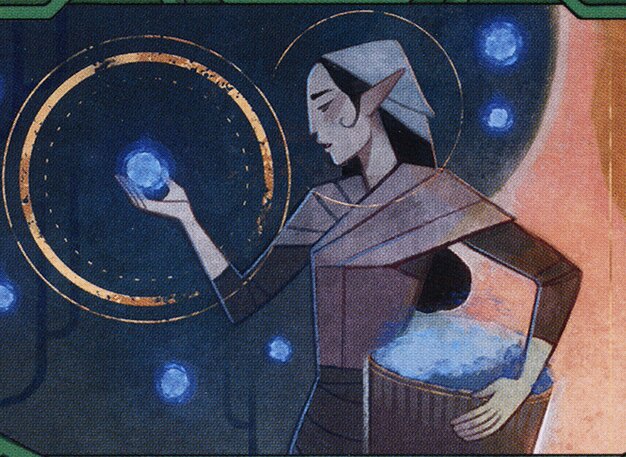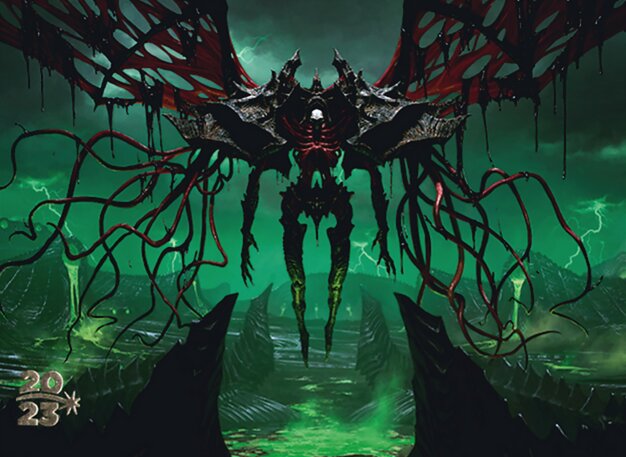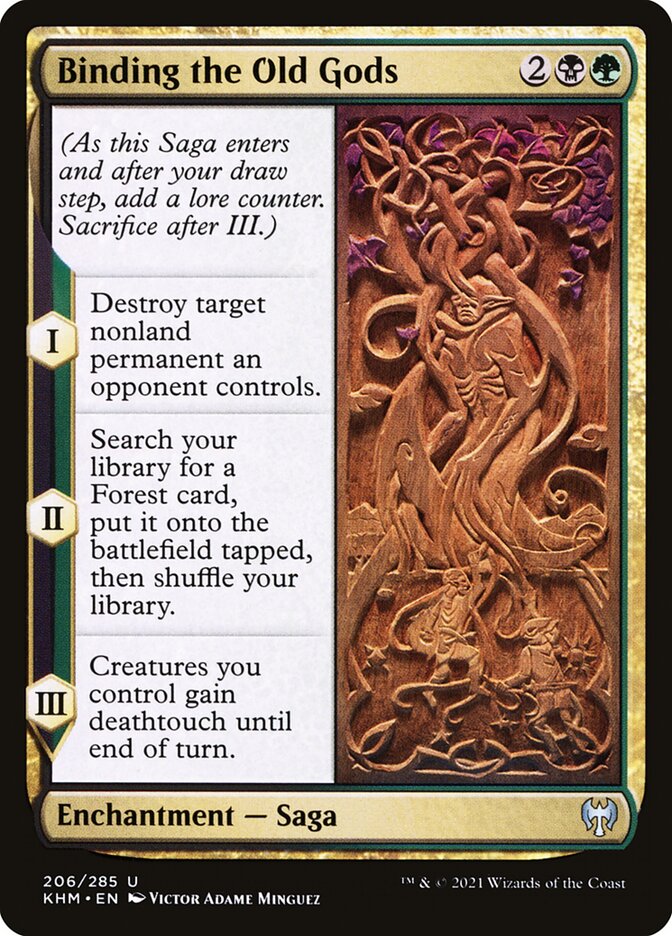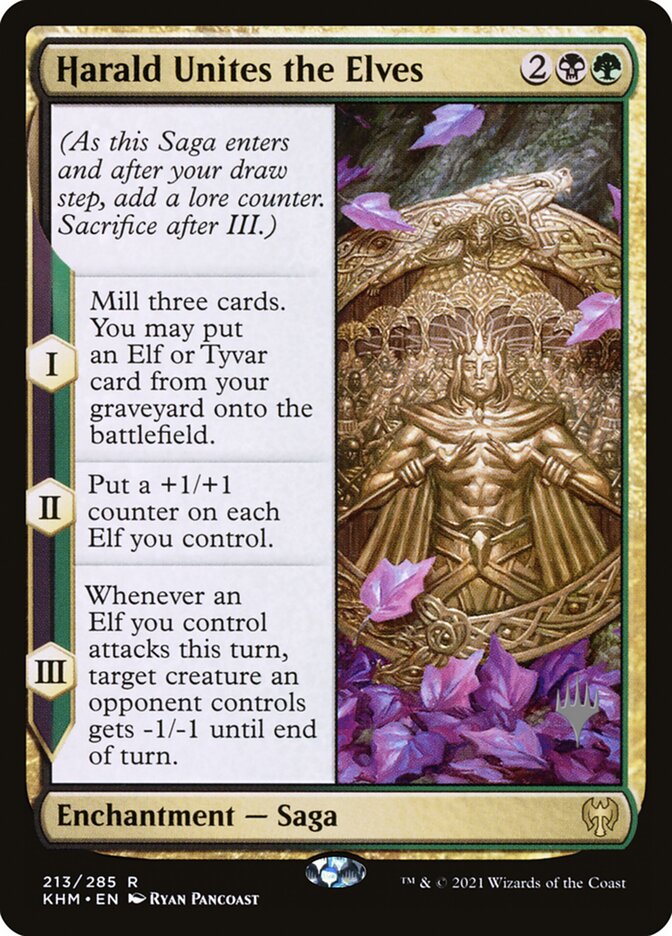Binding the Old Gods MTG Card
| Card sets | Released in 2 setsSee all |
| Mana cost | |
| Converted mana cost | 4 |
| Rarity | Uncommon |
| Type | Enchantment — Saga |
Text of card
(As this Saga enters and after your draw step, add a lore counter. Sacrifice after III.) I — Destroy target nonland permanent an opponent controls. II — Search your library for a Forest card, put it onto the battlefield tapped, then shuffle. III — Creatures you control gain deathtouch until end of turn.
Cards like Binding the Old Gods
Binding the Old Gods is an alluring multistage card that stands out in any game of Magic: The Gathering. With effects that mirror those of other multifaceted cards, it holds its own unique charm. Abundant Growth for instance, like the first stage of Binding the Old Gods, also enables you to not only enchant a land for additional mana but draws a card upon entry. Nevertheless, Binding the Old Gods goes further, bringing creature destruction into play, which Abundant Growth lacks.
Casualties of War is a close parallel with its ability to destroy a mix of target artifacts, creatures, enchantments, lands, and even planeswalkers. While more adaptable in its destructive capabilities, Casualties of War doesn’t boast the land-enhancing effect or the crucial deathtouch boost provided by Binding the Old Gods. Another kindred spell, Maelstrom Pulse, offers versatility with potential to remove multiples of a nonland permanent, but it too doesn’t furnish the additional stages of benefits that make Binding the Old Gods a multifunctional powerhouse.
In the scope of versatility and stage-based control, Binding the Old Gods holds considerable value among similar MTG cards, marked by its ability to disrupt, empower, and ultimately tilt the battlefield in your favor.
Cards similar to Binding the Old Gods by color, type and mana cost
Decks using this card
MTG decks using Binding the Old Gods. Dig deeper into the strategy of decks, sideboard cards, list ideas and export to play in ARENA or MOL.
| # | Name | Format | Archetype | Event |
|---|---|---|---|---|
 | Golgari Midrange | Pioneer | Golgari Midrange | #17 Last Chance Qualifier: Pioneer |
 | Four-color Midrange | Gladiator | Sword and Sandals Showdown: EMEA Week 06 2024 | |
 | Sultai Some Brand of Cereal | Gladiator | Gladiator Proving Grounds: Week 10 2024 | |
 | Four-color Planeswalkers | Gladiator | Sword and Sandals Showdown: AM Week 12 2024 | |
 | Abzan Midrange | Gladiator | Sword and Sandals Showdown: AM Week 08 2024 | |
 | Four-color Combo | Gladiator | Gladiator Team Unified League | |
 | Golgari Control | Gladiator | Gladiator Games: We're Back | |
 | Golgari Aggro | Modern | Golgari Aggro | Last Chance Qualifier Ghent |
 | 5c Enigmatic Fires | Pioneer | 5c Enigmatic Fires | Pioneer League 2024-01-17 |
 | 4c Scapeshift | Pioneer | 4c Scapeshift | Pioneer Showcase Challenge 2024-01-07 |
Card Pros
Card Advantage: Binding the Old Gods bridges the gap between destroying an opponent’s key permanent and enhancing your board presence. Through its second chapter’s effect, it ensures you not only remove a threat but also subsequently draw a crucial forest card right into the battlefield.
Resource Acceleration: Following your disruption of the opponent’s strategy by eradicating their valuable asset, this saga sets the scene for resource acceleration. By fetching a land directly onto the field, Binding the Old Gods accelerates your mana availability, bolstering your capacity to play higher-cost spells earlier than usual.
Instant Speed: While not an instant itself, this multi-chapter saga compensates by delivering a robust effect each upkeep for three turns. This cascade of events perturbs the rhythm of the game, persistently keeping your adversaries on their toes. It mimics the reactionary flexibility of instant-speed plays, maintaining tactical advantage across sequential rounds of play.
Card Cons
Discard Requirement: Although Binding the Old Gods doesn’t directly force you to discard cards, being a multicolor card it pairs well with strategies that may require discards. This can result in a tough decision-making process as you balance resources.
Specific Mana Cost: This enchantment requires a combination of black and green mana, which can limit its inclusion to Golgari decks or those that can accommodate a more complex mana base.
Comparatively High Mana Cost: With a casting cost of three mana, including one black and one green, it might be seen as costly for its initial removal effect, especially when compared to more efficient, lower-cost removal spells available in the color wheel.
Reasons to Include Binding the Old Gods in Your Collection
Versatility: This multiverse saga not only offers efficient creature removal but also facilitates land optimization. It integrates seamlessly into various deck archetypes, particularly those with a strong focus on landfall or graveyard synergy.
Combo Potential: Stage three of the saga grants the ability to tutor for any forest card, including non-basic forests. This aspect can be leveraged in numerous combos, especially in decks that revolve around land-based triggers or need specific land types to activate powerful abilities.
Meta-Relevance: With an ever-evolving competitive scene, having access to efficient, multi-purpose removal and ramp spells gives you an edge. Binding the Old Gods is robust against a wide array of threats due to its ability to disrupt opponents while advancing your mana base—one of the many keys to staying relevant in the current meta.
How to beat
Binding the Old Gods is a versatile removal card in Magic: The Gathering, rising to prominence in decks that favor the integration of creature elimination and land ramping. This card’s first ability adeptly removes any nonland permanent, which makes it indispensable in handling your opponent’s threats. On top of that, it fuels the player’s land growth, potentially accelerating their gameplay significantly by the third turn of its saga.
To effectively counteract Binding the Old Gods, timing is key. Playing less crucial permanents to bait out the removal can conserve your most valuable assets. Additionally, considering that the land tutoring occurs only in the second chapter, disrupting the saga’s progression can stifle an opponent’s momentum. Utilizing instant-speed removal or exile effects targeting enchantments can prevent the further chapters from unfolding. Also, be wary of the deathtouch effect granted in the final chapter, which could turn even the smallest creatures into formidable threats. Therefore, it is crucial to predict the saga’s progression and plan your moves to neutralize the multi-faceted advantage it could provide.
As players assess the varied strategies in Magic: The Gathering, remembering the pivotal interactions and timings can sometimes turn the tide against a well-rounded card like Binding the Old Gods. Knowing when and how to act can make all the difference.
BurnMana Recommendations
Exploring the strategic depths of MTG is a constant endeavor, and cards like Binding the Old Gods exemplify the intricate dance of power and precision. With its ability to dismantle nonland permanents, ramp up your land count, and even bestow deathtouch, the saga offers an array of tactical advancements. As you curate your collection and optimize your deck, consider the symbiotic power plays and land-based synergies this card catalyzes. Stay ahead of the game by incorporating cards that not only challenge opponents but also evolve your gameplay. Join us for deeper insights and to bolster your arsenal with multifaceted gems like Binding the Old Gods.
Where to buy
If you're looking to purchase Binding the Old Gods MTG card by a specific set like Kaldheim and Commander Masters, there are several reliable options to consider. One of the primary sources is your local game store, where you can often find booster packs, individual cards, and preconstructed decks from current and some past sets. They often offer the added benefit of a community where you can trade with other players.
For a broader inventory, particularly of older sets, online marketplaces like TCGPlayer, Card Kingdom and Card Market offer extensive selections and allow you to search for cards from specific sets. Larger e-commerce platforms like eBay and Amazon also have listings from various sellers, which can be a good place to look for sealed product and rare finds.
Additionally, Magic’s official site often has a store locator and retailer lists for finding Wizards of the Coast licensed products. Remember to check for authenticity and the condition of the cards when purchasing, especially from individual sellers on larger marketplaces.
Below is a list of some store websites where you can buy the Binding the Old Gods and other MTG cards:
 BUY NOW
BUY NOW BurnMana is an official partner of TCGPlayer
- eBay
- Card Kingdom
- Card Market
- Star City Games
- CoolStuffInc
- MTG Mint Card
- Hareruya
- Troll and Toad
- ABU Games
- Card Hoarder Magic Online
- MTGO Traders Magic Online
See MTG Products
Printings
The Binding the Old Gods Magic the Gathering card was released in 2 different sets between 2021-02-05 and 2023-08-04. Illustrated by Victor Adame Minguez.
| # | Released | Name | Code | Symbol | Number | Frame | Layout | Border | Artist |
|---|---|---|---|---|---|---|---|---|---|
| 1 | 2021-02-05 | Kaldheim | KHM | 206 | 2015 | Saga | Black | Victor Adame Minguez | |
| 2 | 2023-08-04 | Commander Masters | CMM | 917 | 2015 | Saga | Black | Victor Adame Minguez |
Legalities
Magic the Gathering formats where Binding the Old Gods has restrictions
| Format | Legality |
|---|---|
| Commander | Legal |
| Historic | Legal |
| Legacy | Legal |
| Modern | Legal |
| Oathbreaker | Legal |
| Vintage | Legal |
| Duel | Legal |
| Explorer | Legal |
| Gladiator | Legal |
| Brawl | Legal |
| Pioneer | Legal |
| Timeless | Legal |
Rules and information
The reference guide for Magic: The Gathering Binding the Old Gods card rulings provides official rulings, any errata issued, as well as a record of all the functional modifications that have occurred.
| Date | Text |
|---|---|
| 2021-02-05 | A chapter ability doesn’t trigger if a lore counter is put on a Saga that already had a number of lore counters greater than or equal to that chapter’s number. For example, the third lore counter put on a Saga causes the chapter III ability to trigger, but chapters I and II won’t trigger again. |
| 2021-02-05 | As a Saga enters the battlefield, its controller puts a lore counter on it. As your precombat main phase begins (immediately after your draw step), you put another lore counter on each Saga you control. Putting a lore counter on a Saga in either of these ways doesn’t use the stack. |
| 2021-02-05 | Each symbol on the left of a Saga’s text box represents a chapter ability. A chapter ability is a triggered ability that triggers when a lore counter that is put on the Saga causes the number of lore counters on the Saga to become equal to or greater than the ability’s chapter number. Chapter abilities are put onto the stack and may be responded to. |
| 2021-02-05 | If multiple chapter abilities trigger at the same time, their controller puts them on the stack in any order. If any of them require targets, those targets are chosen as you put the abilities on the stack, before any of those abilities resolve. |
| 2021-02-05 | Once a chapter ability has triggered, the ability on the stack won’t be affected if the Saga gains or loses counters, or if it leaves the battlefield. |
| 2021-02-05 | Once the number of lore counters on a Saga is greater than or equal to the greatest number among its chapter abilities, the Saga’s controller sacrifices it as soon as its chapter ability has left the stack, most likely by resolving or being countered. This state-based action doesn’t use the stack. |
| 2021-02-05 | Removing lore counters won’t cause a previous chapter ability to trigger. If lore counters are removed from a Saga, the appropriate chapter abilities will trigger again when the Saga receives more lore counters. |









